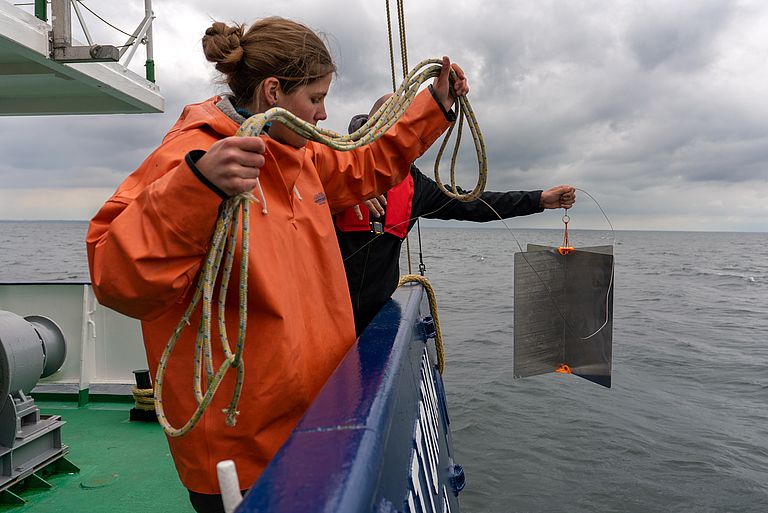Searching for genetic traces in the Baltic Sea
GEOMAR scientists explore the distribution of environmental DNA
The search for genetic traces begins on a Monday morning at 7:15 a.m. on the pier of GEOMAR Helmholtz Centre for Ocean Research Kiel: After months of preparations, scientists are finally able to test for how long dissolved genetic material of living organisms can be detected in the Baltic Sea during an expedition with the research cutter LITTORINA. The approach is called “environmental DNA” (eDNA) in reference to deoxyribonucleic acid (DNA), which contains an organism’s genetic information.
“Unlike the air, we cannot see into the ocean. We cannot directly see which organisms are in the water column, have just swum past – and certainly not which ones were there a week ago,” says Dr. Lara Schmittmann, postdoctoral researcher at GEOMAR. Together with her colleague, the marine biologist Dr. Véronique Merten, she is implementing the “traceDNA” project, which is funded as part of the GEOMAR Call for Postdoctoral Activities 2022.
For the “environmental DNA” method, only small samples from the environment are needed to obtain information about existing living organisms. This is possible because plants, animals and other organisms leave tiny traces of their genetic material. Their DNA can be extracted and analysed from seawater, for example, but also from sediment. It contains genetic information that makes it possible to identify species, map their distribution, analyse their diversity and monitor ecological changes over time without capturing or disturbing the organisms themselves.
The challenge: It is not clear yet how long DNA traces can be detected in the ocean. Therefore, it is difficult to make statements about the temporal and spatial distribution of species based on environmental DNA. “For example, if you find DNA traces of sprat in a water sample from a certain position in the Eckernförde Bay, you cannot differentiate whether a fish has been there, or even a whole school of fish, and whether the sprat was there a day or a week ago, or ten kilometres further away,” illustrates Dr Schmittmann.
“Our project is an important step in advancing environmental DNA as a non-invasive approach to studying oceans and ecosystems,” explains Dr Véronique Merten. “It's the next step to use the method not only to study distribution patterns, but also to determine the frequency of occurrence of different species.”
For the LITTORINA expedition, the team used simulations of currents and weather forecasts to determine the optimal deployment site for their experiment: Near Kiel Lighthouse, the scientists release the DNA of carp into the Baltic Sea and track their whereabouts for two weeks using water samples. Because this fish species does not occur in the Baltic Sea, the researchers can be sure that any traces of carp DNA they discover later in their analyses has to come from the experiment. The experiment aims to link the amount of DNA found at a site with the original biomass, an important parameter for fisheries management. A better understanding of the spatial distribution, residence time and origin of environmental DNA is crucial for holistic biodiversity assessments and can thus contribute to the management of marine protected areas.
“To our knowledge, our project is the first to conduct environmental DNA experiments directly in the ocean. The combination of an experiment in a natural environment and hydrodynamic models has potential to predict the distribution of environmental DNA in different oceanographic regions for all types of marine life in the future,” explains Dr. Lara Schmittmann. “To achieve this, scientists from different disciplines at GEOMAR and the Helmholtz Centre Hereon are working together. Thus, we combine expertise in physical oceanography, ocean modelling, marine ecology, molecular genetics and biogeochemical tracers.”
After deploying the sample material at a depth of three metres, surface drifters with GPS transmitters are released into the water. They help track the water masses into which the DNA was placed. An ocean current model in combination with the positions of the drifters should make it possible to track the DNA traces over the course of the experiment. Analyses of water samples from the Baltic Sea will show whether the approach works in the coming weeks.
“A study like this is important because it has the potential to improve our understanding of the distribution of environmental DNA in marine ecosystems,” emphasises Dr. Véronique Merten. “Through our study, we are learning more about the ecology of environmental DNA: How long can environmental DNA be detected, how widely is it distributed, how quickly is it degraded? This information is important to better interpret corresponding studies in the future.”
Dr. Lara Schmittmann adds: “Furthermore, our study offers an approach to correlate environmental DNA with biomass. This is necessary to further develop the method so that in the future not only the presence or absence of species can be estimated, but also their spatial distribution and abundance.”
In the future, Dr. Véronique Merten and Dr. Lara Schmittmann plan to expand their collaboration and take further steps in research on environmental DNA. This experiment provides the basis for further in-depth studies.

Taking water samples from the rosette water sampler for later analysis. Photo: Sarah Kaehlert, GEOMAR

On board LITTORINA, the seawater is filtered. The DNA analysis will take place later in the laboratory. Photo: Sarah Kaehlert, GEOMAR

Deployment of a surface drifter to track water masses. Photo: Sarah Kaehlert, GEOMAR

Dr. Lara Schmittmann und Dr. Véronique Merten look forward to the start of the experiment. Photo: Sarah Kaehlert, GEOMAR

Dr. Lara Schmidtmann and Felix Kirch compare the calculated best position for inserting the DNA on the sea chart. Photo: Sarah Kaehlert, GEOMAR


